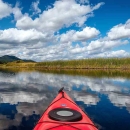
The Auto Tour Route and Sellin Bike Trail into the refuge are now open. Please exercise caution as some fires are still smoldering. Many trees are unstable and could still fall unexpectedly.
Fire is a natural part of prairie ecosystems. Historically started by indigenous peoples and lightning, fires play a vital role in removing dead litter and trees from open prairie landscapes. While dark smoke releases some CO2 into the atmosphere during the burn, the removal of dead vegetation prompts vigorous root growth that permanently captures CO2 deep underground. This further enriches the black soil for which the Midwest is famous. Many native wildflowers experience massive blooms after fires, increasing seed production and benefiting pollinators, while invasive species invasive species
An invasive species is any plant or animal that has spread or been introduced into a new area where they are, or could, cause harm to the environment, economy, or human, animal, or plant health. Their unwelcome presence can destroy ecosystems and cost millions of dollars.
Learn more about invasive species are suppressed. While some wildlife may perish in the fires, most are able to flee or escape underground. Fires are conducted early enough that many bird species will renest if their nests are lost. In the long-term, fire maintains open prairie landscapes, which are crucial for the long-term persistence of many threatened and endangered prairie adapted species.
Visit Us
The Auto Tour Route is open the first Monday in April to the first Monday in December unless otherwise noted in the alerts on our Home Page.
Connect with your natural heritage as you experience wildlife, diverse habitats and magnificent granite outcrops at Big Stone National Wildlife Refuge.
Location and Contact Information
- Big Stone National Wildlife RefugeView Details44843 County Road 19 Odessa, MN 56276-2062























